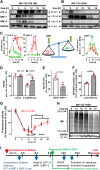Prevention of neuronal apoptosis by astrocytes through thiol-mediated stress response modulation and accelerated recovery from proteotoxic stress
- PMID: 30390092
- PMCID: PMC6261954
- DOI: 10.1038/s41418-018-0229-x
Prevention of neuronal apoptosis by astrocytes through thiol-mediated stress response modulation and accelerated recovery from proteotoxic stress
Abstract
The development of drugs directly interfering with neurodegeneration has proven to be astonishingly difficult. Alternative therapeutic approaches could result from a better understanding of the supportive function of glial cells for stressed neurons. Therefore, here, we investigated the mechanisms involved in the endogenous neuro-defensive activity of astrocytes. A well-established model of postmitotic human dopaminergic neurons (LUHMES cells) was used in the absence ('LUHMES' mono-culture) or presence ('co-culture') of astrocytes. Inhibition of the LUHMES proteasome led to proteotoxic (protein aggregates; ATF-4 induction) and oxidative (GSH-depletion; NRF-2 induction) stress, followed by neuronal apoptosis. The presence of astrocytes attenuated the neuronal stress response, and drastically reduced neurodegeneration. A similar difference between LUHMES mono- and co-cultures was observed, when proteotoxic and oxidative stress was triggered indirectly by inhibitors of mitochondrial function (rotenone, MPP+). Human and murine astrocytes continuously released glutathione (GSH) into the medium, and transfer of glia-conditioned medium was sufficient to rescue LUHMES, unless it was depleted for GSH. Also, direct addition of GSH to LUHMES rescued the neurons from inhibition of the proteasome. Both astrocytes and GSH blunted the neuronal ATF-4 response and similarly upregulated NRF-1/NFE2L1, a transcription factor counter-regulating neuronal proteotoxic stress. Astrocyte co-culture also helped to recover the neurons' ability to degrade aggregated poly-ubiquitinated proteins. Overexpression of NRF-1 attenuated the toxicity of proteasome inhibition, while knockdown increased toxicity. Thus, astrocytic thiol supply increased neuronal resilience to various proteotoxic stressors by simultaneously attenuating cell death-related stress responses, and enhancing the recovery from proteotoxic stress through upregulation of NRF-1.
Conflict of interest statement
The authors declare that they have no conflict of interest.
Figures






Similar articles
-
Switching from astrocytic neuroprotection to neurodegeneration by cytokine stimulation.Arch Toxicol. 2017 Jan;91(1):231-246. doi: 10.1007/s00204-016-1702-2. Epub 2016 Apr 6. Arch Toxicol. 2017. PMID: 27052459
-
Activation of transcription factor Nrf-2 and its downstream targets in response to moloney murine leukemia virus ts1-induced thiol depletion and oxidative stress in astrocytes.J Virol. 2004 Nov;78(21):11926-38. doi: 10.1128/JVI.78.21.11926-11938.2004. J Virol. 2004. PMID: 15479833 Free PMC article.
-
Astrocytes protect MN9D neuronal cells against rotenone-induced oxidative stress by a glutathione-dependent mechanism.Sheng Li Xue Bao. 2007 Jun 25;59(3):253-9. Sheng Li Xue Bao. 2007. PMID: 17579777
-
The consequences of methylmercury exposure on interactive functions between astrocytes and neurons.Neurotoxicology. 2002 Dec;23(6):755-9. doi: 10.1016/S0161-813X(01)00076-6. Neurotoxicology. 2002. PMID: 12520765 Review.
-
Mechanisms of Endogenous Neuroprotective Effects of Astrocytes in Brain Injury.Oxid Med Cell Longev. 2018 Apr 1;2018:6501031. doi: 10.1155/2018/6501031. eCollection 2018. Oxid Med Cell Longev. 2018. PMID: 29805731 Free PMC article. Review.
Cited by
-
Enhanced differentiation of human dopaminergic neuronal cell model for preclinical translational research in Parkinson's disease.Biochim Biophys Acta Mol Basis Dis. 2020 Apr 1;1866(4):165533. doi: 10.1016/j.bbadis.2019.165533. Epub 2019 Aug 20. Biochim Biophys Acta Mol Basis Dis. 2020. PMID: 31442530 Free PMC article.
-
Diverse maturity-dependent and complementary anti-apoptotic brakes safeguard human iPSC-derived neurons from cell death.Cell Death Dis. 2022 Oct 21;13(10):887. doi: 10.1038/s41419-022-05340-4. Cell Death Dis. 2022. PMID: 36270985 Free PMC article.
-
Docosahexaenoic Acid (DHA) Inhibits FADS2 Expression in Astrocytes but Increases Survival of Neurons Co-cultured with DHA-enriched Astrocytes.Int J Mol Cell Med. 2019 Summer;8(3):232-240. doi: 10.22088/IJMCM.BUMS.8.3.232. Int J Mol Cell Med. 2019. PMID: 32489952 Free PMC article.
-
Basal activation of astrocytic Nrf2 in neuronal culture media: Challenges and implications for neuron-astrocyte modelling.Brain Neurosci Adv. 2025 Jul 24;9:23982128251351360. doi: 10.1177/23982128251351360. eCollection 2025 Jan-Dec. Brain Neurosci Adv. 2025. PMID: 40718467 Free PMC article.
-
A Diet Containing Rutin Ameliorates Brain Intracellular Redox Homeostasis in a Mouse Model of Alzheimer's Disease.Int J Mol Sci. 2023 Mar 2;24(5):4863. doi: 10.3390/ijms24054863. Int J Mol Sci. 2023. PMID: 36902309 Free PMC article.
References
-
- Langley M, Ghosh A, Charli A, Sarkar S, Ay M, Luo J, et al. Mito-apocynin prevents mitochondrial dysfunction, microglial activation, oxidative damage, and progressive neurodegeneration in MitoPark transgenic mice. Antioxid Redox Signal. 2017;27:1048–66. doi: 10.1089/ars.2016.6905. - DOI - PMC - PubMed
Publication types
MeSH terms
Substances
LinkOut - more resources
Full Text Sources

